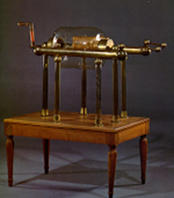
120 x 66 x 124
Glass, brass, leather and wood
CAT. 1851 : 10 - 1.st sala
Outra dita tambem de Nairne, mas de maiores dimensoens, e conductores de lataõ. É montada sobre uma mesa de nogueira e fica fora dos armarios na - 1.ª sala.
Another Nairne machine, but larger, and with brass conductors. It is mounted on a walnut table and is outside the cabinets in the 1st room.
This model of Nairne electrostatic machine was widely known in England at the end of the 18th century. It consists of a horizontal glass cylinder, rotated by a handle on its longitudinal axis. The cylinder's axis is held on two glass supports which also act as insulators. On either side of the glass tube are two separate, cylindrical brass conductors, supported by two glass columns, parallel to its axis and on the same horizontal plane.
As the cylinder rotates, the glass rubs against a leather pad fixed to one of the conductors. When the device is operating, this conductor is negatively charged as it collects the charge generated on the pad by friction. The other conductor has a group of sharp tips pointing in the direction of the glass cylinder, with their ends a few centimetres from it. These tips have a negative charge, by induction, resulting from their proximity to the glass cylinder. The small distance between the two opposing charge distributions permits continuous discharge. The aim of the experiment is to demonstrate the importance of the tips in the process of charging the machine's metal conductor.
The two charge collectors each have a jointed conductor on the end opposite the handle. Electrical discharges can be produced between them when their ends are close enough.
When only one kind of electrical charge is wanted, either positive or negative, one of the cylindrical conductors should be connected to the earth, thus improving the machine's efficiency.
Daguin, Pierre-Adolphe, Traité Élémentaire de Physique Théorique et Expérimentale, Paris, 1867, Vol. III, Book V, n.º 1606.